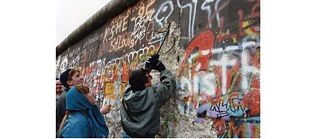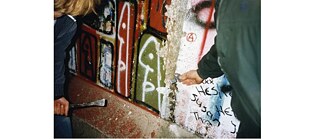Chapter 6
How the wall became mere material

Regular blows resound, from a distance they sound like a festival of uninhibited DIY-ers. But in the weeks following the fall of the Berlin Wall, the hammer - actually the symbol of the workers on the GDR flag - is striking thousands of times against the concrete.
By Regine Hader and Dr. Andreas Ludwig
For years, the Wall has been a real structural barrier for both sides of the city, cutting off tram tracks, limiting possibilities, relationships and routes. At the same time, however, the Wall was also a symbol of the Cold War, of the either/or of affiliation with the political blocs - either the reactionary politics of consumption or the socialist absence of freedom. It symbolised an order that does not tolerate any nuances and confronts the citizens on both sides with their own powerlessness. On these November days they also free themselves physically.

In this scene between the Reichstag and Potsdamer Platz, a "Mauerspecht " is sitting atop the Wall, one leg in the west, one in the east. The aesthetics of this time are permeated by contrasts: situations that seemed impossible a few days earlier allow people to breathe freedom and feel alive. Hours in which everything seems open.